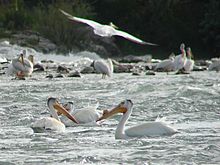Minidoka National Wildlife Refuge
| Minidoka National Wildlife Refuge | ||
|---|---|---|
| Semi-arid zone | ||
|
|
||
| Location: | Idaho , United States | |
| Next city: | Rupert | |
| Surface: | 84 km² | |
| Founding: | 1909 | |
| Entrance sign | ||
The Minidoka National Wildlife Refuge is a 84 km² large protected area of the National Wildlife Refuge System in the south of the US state Idaho . The area is in the Snake River Plain on the banks of the Snake River in south-central Idaho, approximately 20 km from Rupert . It includes about 200 km of the shoreline of Lake Walcott and extends about 40 km upstream.
About half of the protected area consists of water or wetlands. In the dry environment, this oasis attracts many animals from the area. Many species use the small bays on the banks overgrown with bulrushes as retreats. Other animals use the willows , poplars and other trees that grow near the shore. The rest of the area is flat, covered with sagebrush , grasses and isolated clusters of juniper .
climate
With an annual average of less than 300 mm of precipitation, the climate is semi-arid . A large part of this is due to winter snowfall. The summers are hot and dry, interrupted by thunderstorms with extremely variable amounts of precipitation. The area is about 1,280 meters above sea level.
Minidoka Dam
The construction of the Minidoka Dam and the power station on the Snake River began in 1904 by the Bureau of Reclamation for the purpose of supplying water to agriculture and ensuring electricity generation. The reservoir that formed was named Lake Walcott. In this arid region, the lake and the surrounding area quickly attracted a large number and diversity of wildlife. This was the reason for putting the area under protection early on.
Birds
Minidoka is a link in the chain of Pacific bird migration. The reserve is used as a resting place every spring and autumn by a wide variety of migratory birds, mainly waterfowl . During this time, around 500 dwarf swans regularly stop here.
Unlike most moulting birds , which gradually change plumage, waterfowl lose the plumage of the wings and tail all at once. They are unable to fly for about a month while the wings grow back. The secluded, undisturbed bays of the area with lush vegetation can attract 100,000 molting ducks and geese during the months of July to September.
The open water surface, the alluvial land and the mudflats form the habitat for numerous water birds. Racing and Clark divers , American coots and wedge-tailed plovers are easy to spot. Careful observers may also spot common loons and waders such as the mud treaders , American avocets, and the Wilson water treaders.
Some birds rely on mutual help and secrete to protect themselves from predators. These prefer to nest in colonies on isolated, small islands or in the groves of large trees. Often several bird species nest together in a colony. These birds are mainly racing and clark divers, scabbards , great blue herons , night herons , rhinoceros pelicans , California gulls , sometimes also great egrets and cattle egrets . Parts of the area are closed to the public during the nesting season to protect the breeding colonies from disturbance.
Over 230 different species have been spotted in minidoka. Because of the breeding colonies and the resulting concentration of waterfowl, the area has been designated by the American Bird Conservancy as a bird sanctuary of worldwide importance. Some resident birds such as B. tail grouse , mugwort , pheasant , partridge and some songbirds can be found all year round. Others are only found in summer or during bird migration.
Bald eagles can be seen regularly in the fall and winter.
Mammals
Large numbers of mammals can also be encountered in Minidoka. Mule deer can be seen regularly near the ranger station. Pronghorns occur in small numbers in the open areas overgrown with sagebrush. Smaller mammals found include the Canadian beaver , cottontail rabbit , prairie hare , muskrat , urson , raccoon , striped skunk , American mink , coyote and various bats . The North American river otter can also sometimes be seen. Very rare visitors are Puma , Bobcat , wapiti and moose .
Web links
- US Fish and Wildlife Service: Minidoka National Wildlife Refuge (official site, English)




